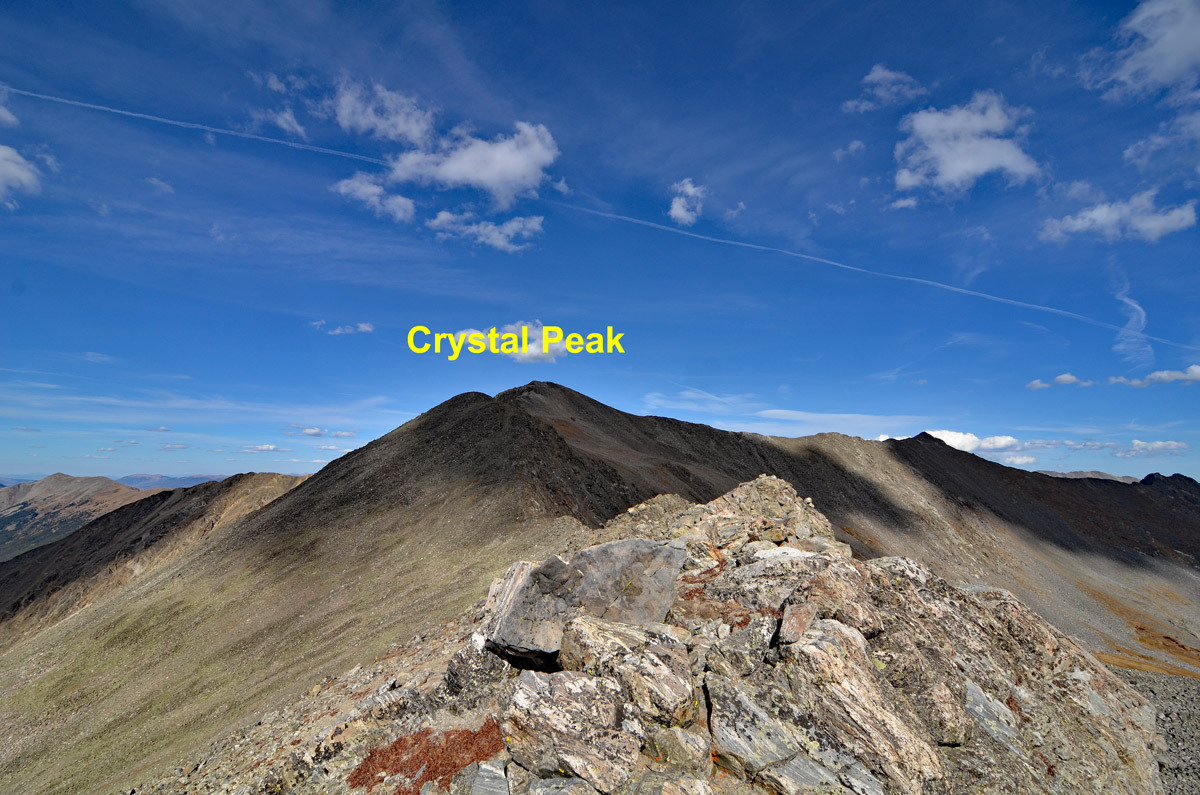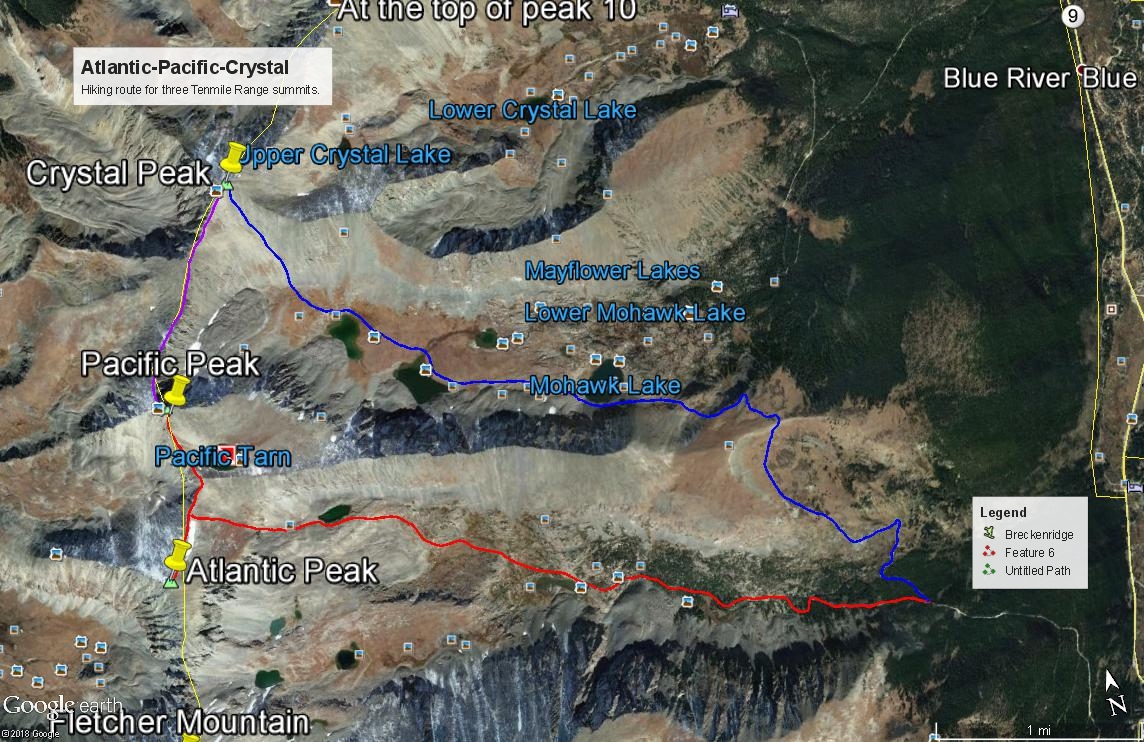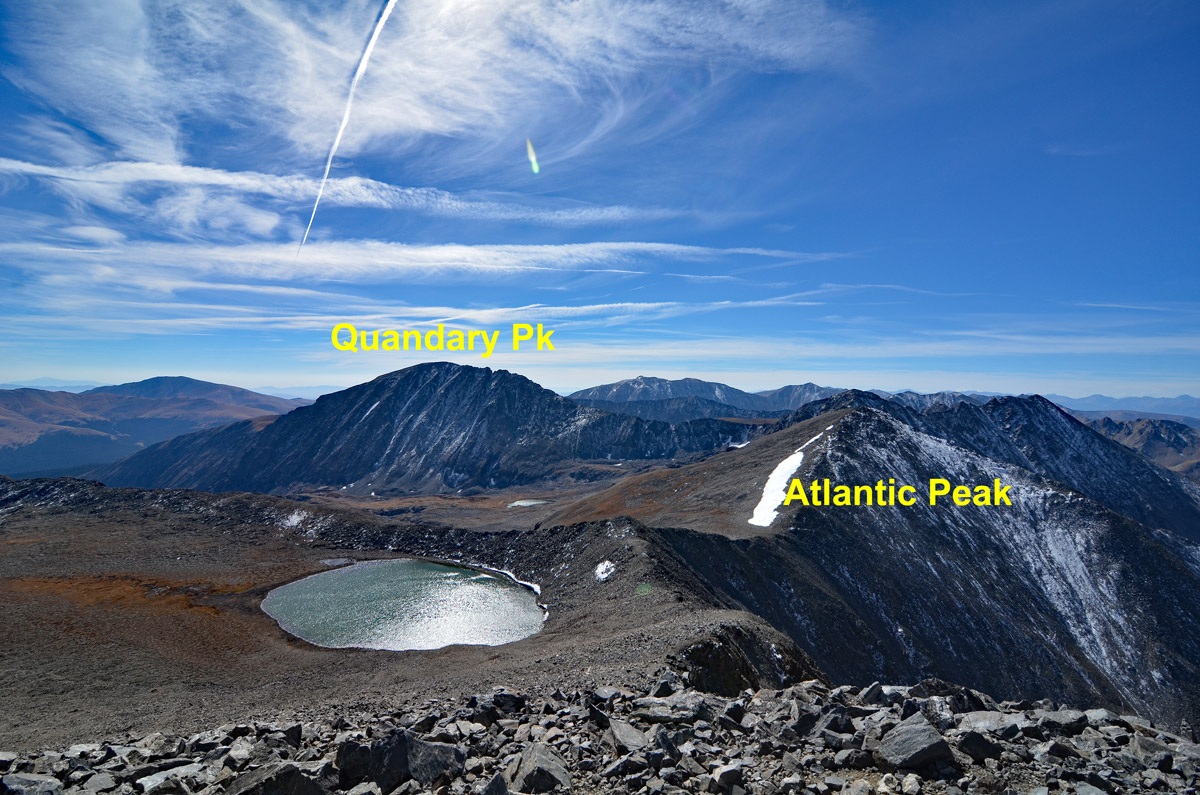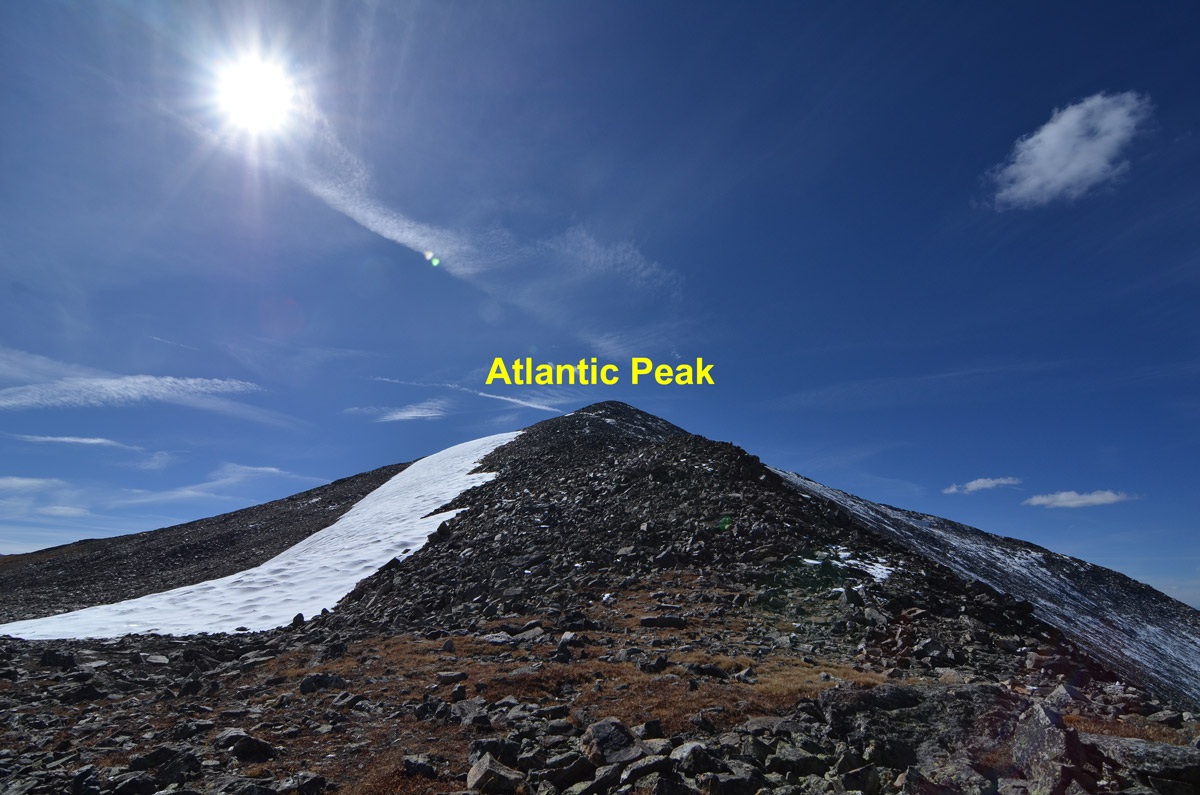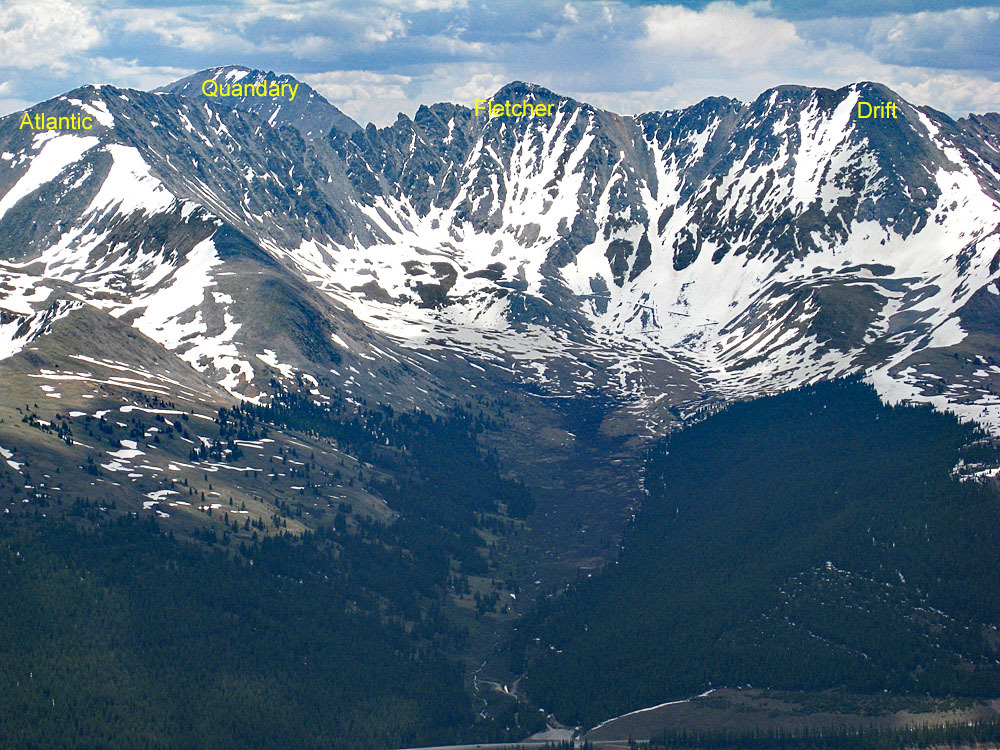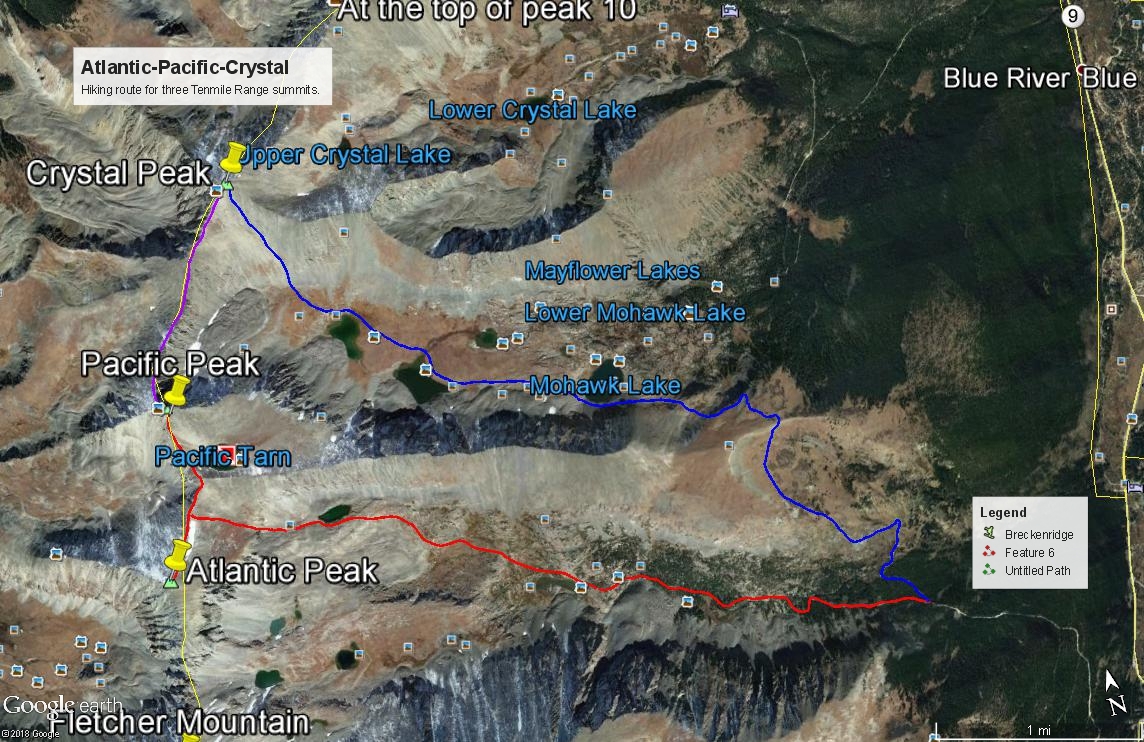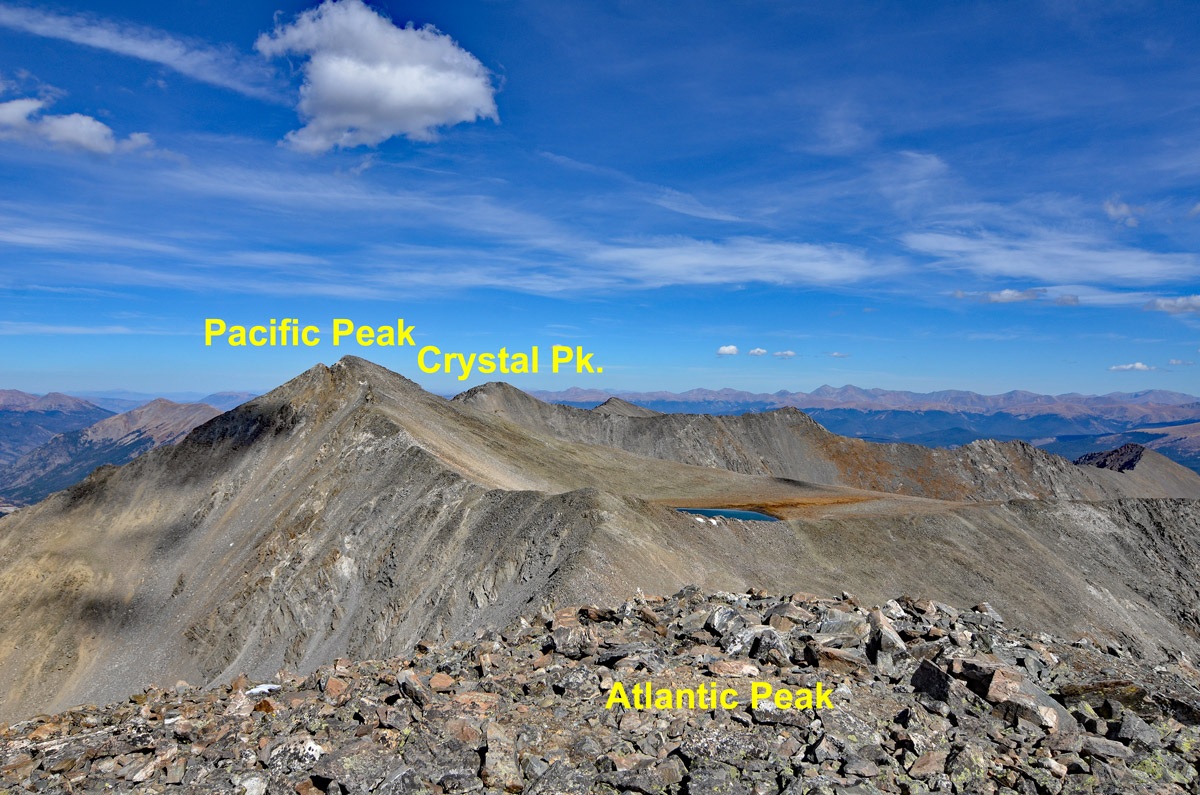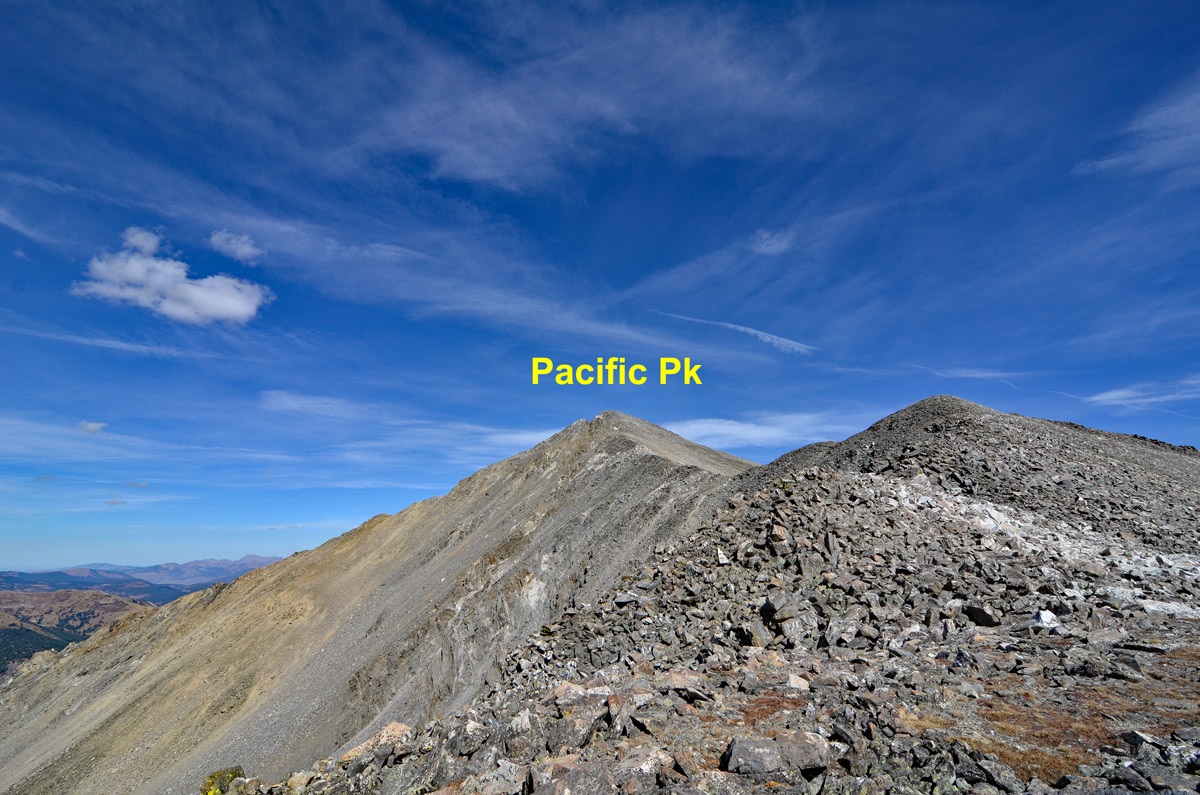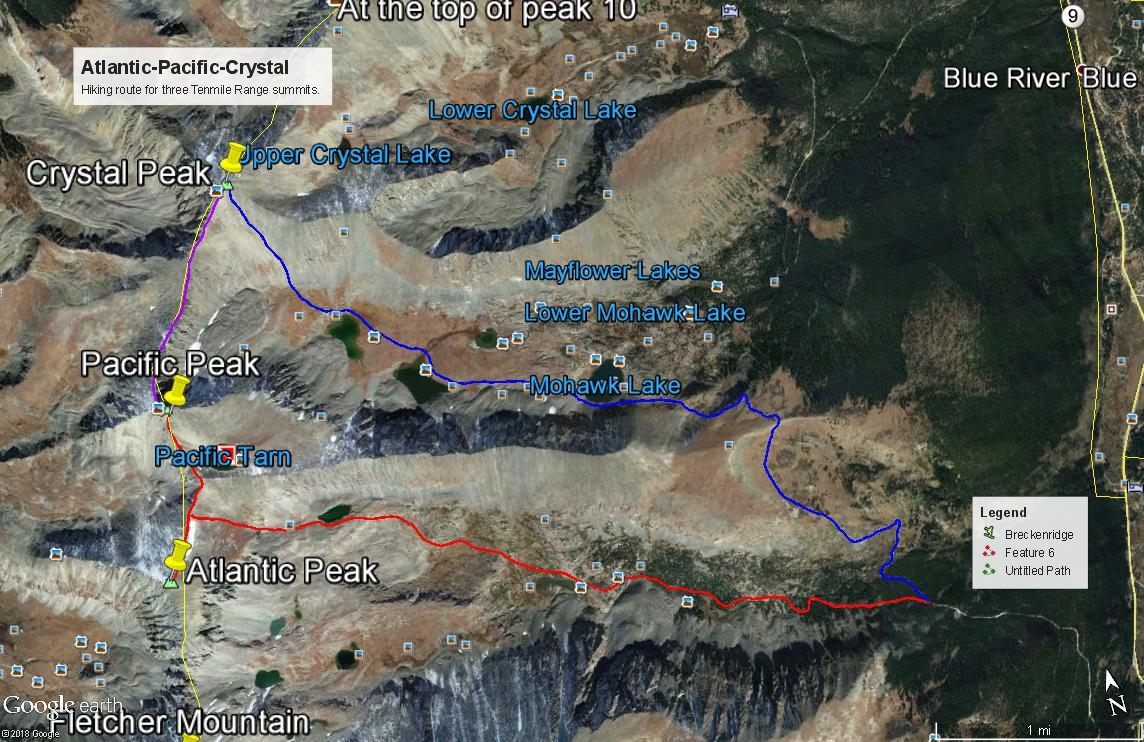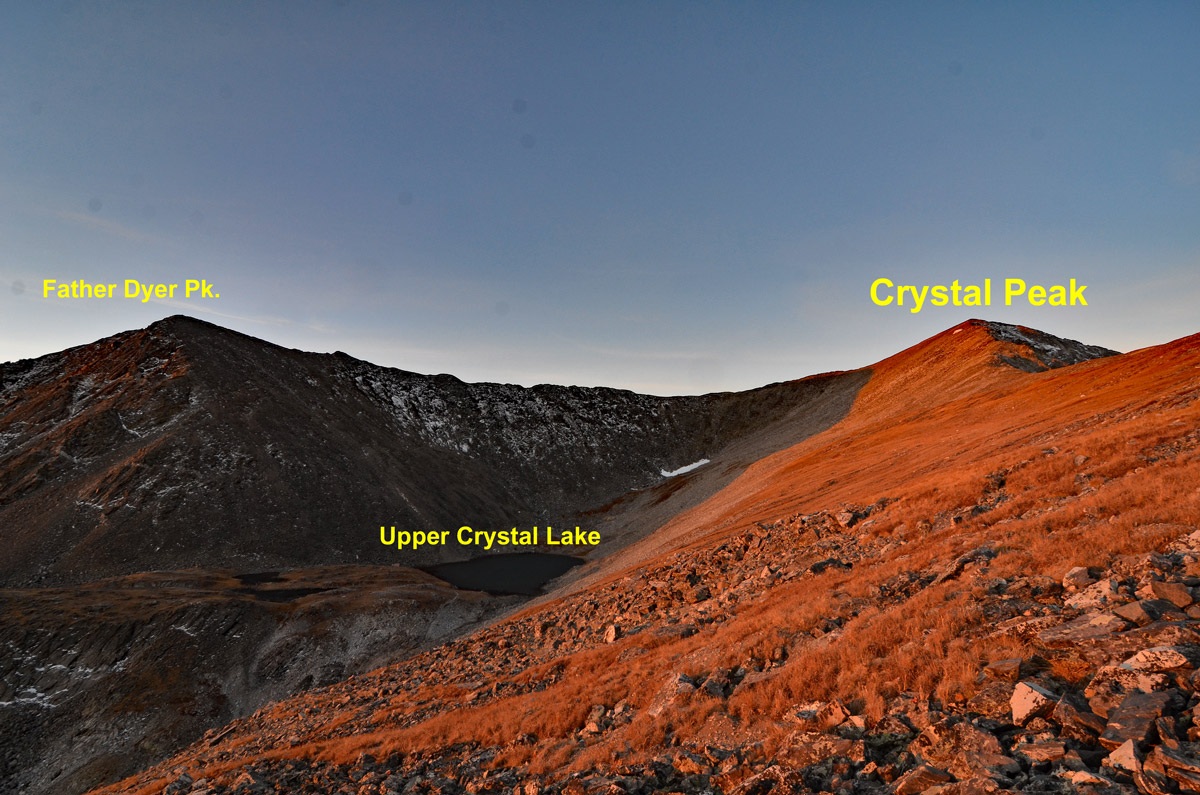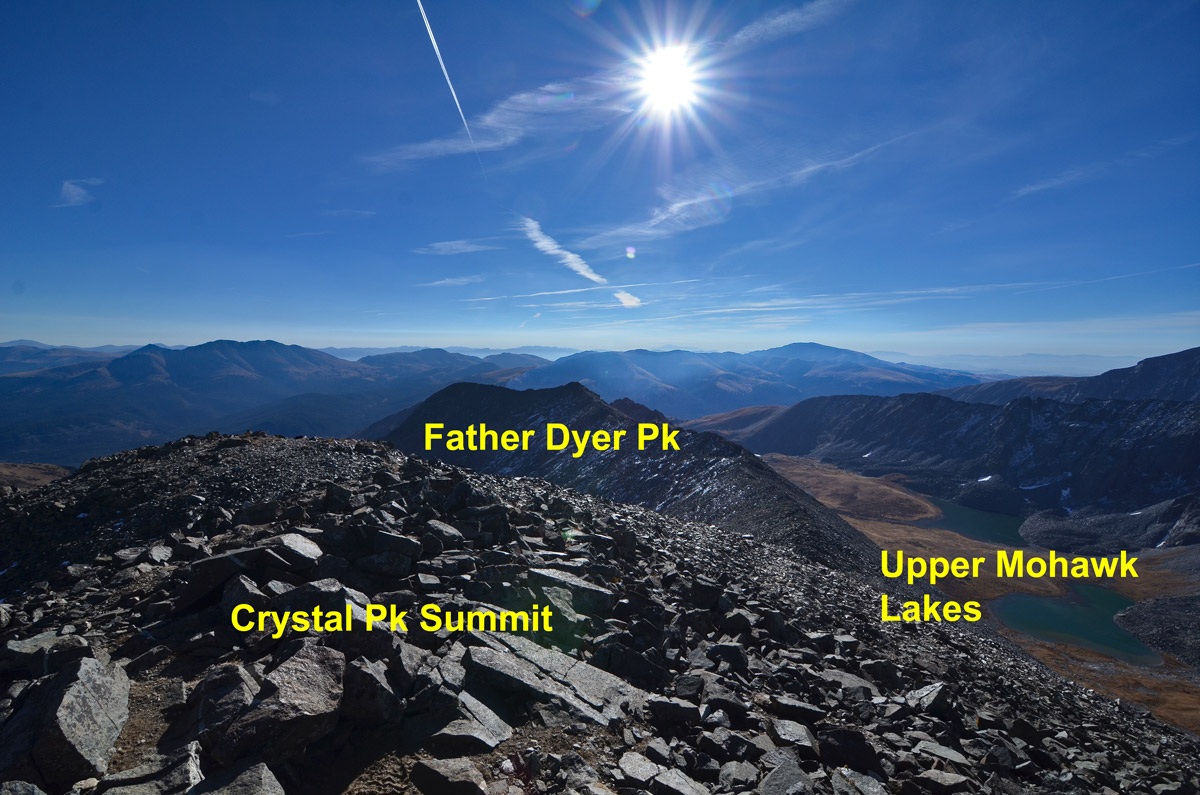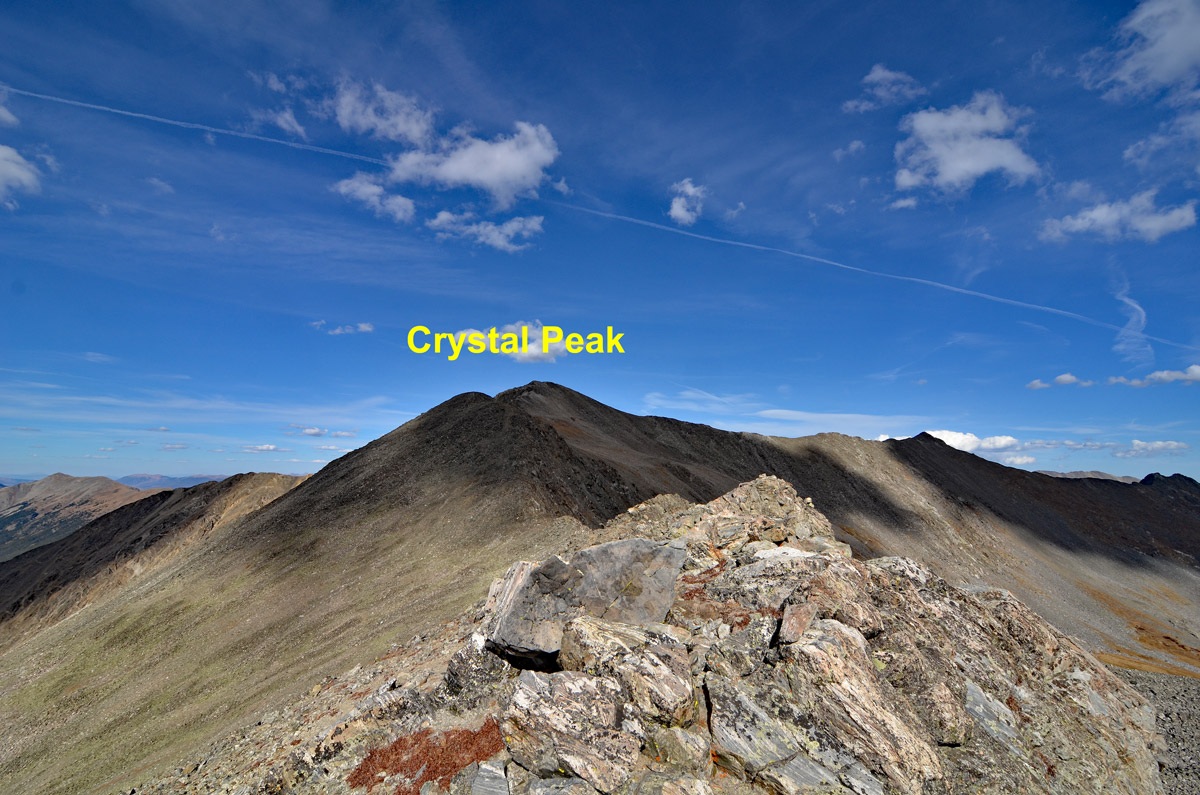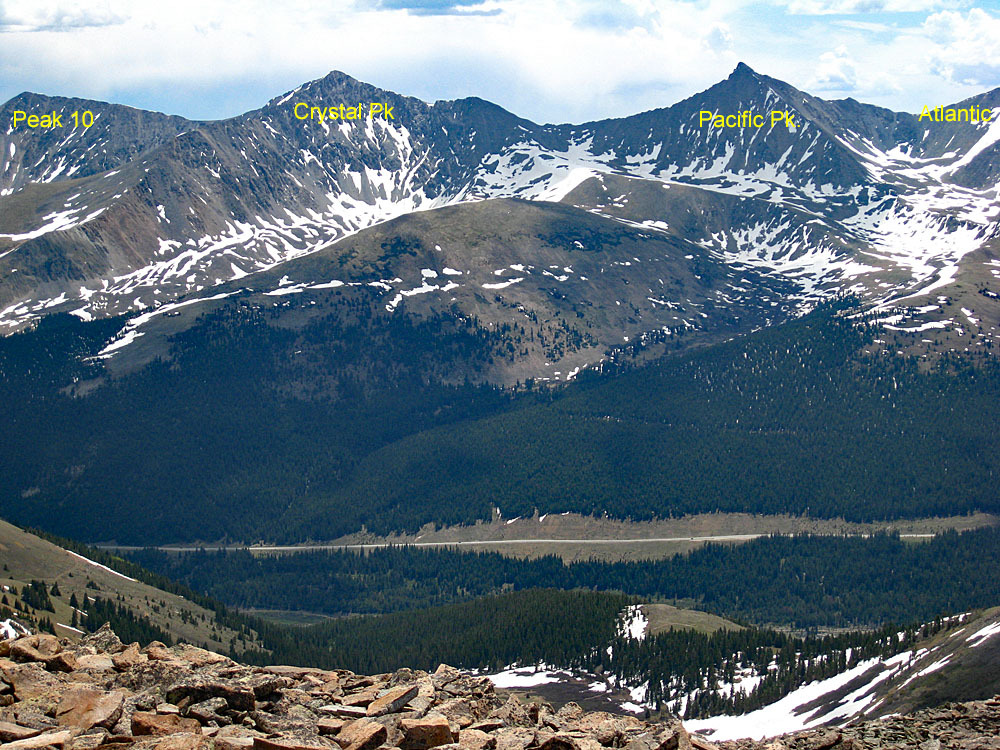LoJ: #83 (Pre-LiDAR #82) / 13,860' Crystal Peak
Peak Summary
Crystal Peak is a Class 2 hike in the Tenmile Range SW of Breckenridge, CO. The McCullough Gulch Trailhead is our proposed primary route access point and can be reached by most passenger vehicles. The county road access to the gulch is the same as that used for the 14er, Quandary Peak, so weekend use in this area can be quite heavy, but those seeking the high 13ers will find much more solitude than the peakbagging hordes heading up Quandary. Crystal is sequenced with Atlantic and Pacific and our loop hike provides an opportunity to visit two beautiful drainages with high alpine lakes and abundant summer wildflowers. The second drainage visited is that of Spruce Creek. Pacific and Crystal can easily be accessed alone from the Spruce Creek TH.
Crystal Peak SW Ridge Route
-
Trailhead
Approach Map Photos
-
McCullough Gulch TH
The trailhead for McCullough Gulch uses the same directions as for Quandary Peak, initially. If coming from Breckenridge on SH 9, drive south from the center of town approximately 8 miles where you turn right (west) onto "Blue Lakes Road #850.
If coming from Hoosier Pass on SH 9, drive north from the summit of the pass just over 2 miles to the left turn (west) onto Blue Lakes Road #850.
NOTE: As of July 30, 2021, parking for either Quandary Peak or McCullough Gulch has been regulated. A parking permit must be obtained in advance at a significant cost, or you must ride a shuttle in from the airport north of Breckenridge to the trailhead. Check out this link for more info: https://www.parkquandary.com/ The shuttle will drop visitors off at the intersection described below. If you do not want to "pay-to-play" or utilize the shuttle, then an unregulated access can be found by using the Spruce Creek-Mohawk Lakes TH described on this site.Once on CR 850, drive past the large, day-use parking lot and make a right turn (north) onto CR 851. This is the same road that takes you to the well-used east ridge approach for Quandary. If arriving here on a summer weekend, drive past the multitude of cars parked along the road left by 14er baggers, and continue north, to NW for 1.7 mile to an intersection. The trailhead coordinates provided are for this intersection. If you can find a place to park, do so nearby to begin your hike. The road to this point is typically drivable by passenger vehicles. If no parking is readily available, take the left fork and you may be able to drive another .5 mile to a locked gate and a place where you can park at 11,090 ft. at these coordinates: N 39° 24' 03.99" W 106° 04' 45.23". Alternately, you can also take the right fork and drive down to the creek and park.
Camping
Overnight parking at any of the parking areas for Quandary is prohibited. Some at-large camping may be available in the area of the trailheads identified, especially down by McCullough Creek. But if arriving on a summer weekend, most any decent spot will likely be taken and these may now be prohibited as well. There are no National Forest campgrounds in the immediate vicinity. For campgrounds located near Dillon Res., try this site for more information: http://www.townofdillon.com/visit/camping-info.
-
From Atlantic Peak Pacific Peak
-
Atlantic Peak North Ridge Class 2 / 4.25 mi / 2,800’ One-Way
Click thumbnail to view full-size photo + caption
Open This Route in a New WindowPlease Note: The McCullough Gulch TH access is now regulated and a parking permit is required, or a shuttle must be taken from the airpost north of Breckenridge to the trailhead, as of July 30, 2021. See the trailhead description for more information.
Atlantic Peak is sequenced with Pacific and Crystal. In this presentation, Atlantic serves as the first summit of a three-peak day that includes three, Top 100 summits, an uncommon combination for those attempting to climb the 100 highest. This circuit hike will take you across a wide variety of terrains. In earlier season, an ice axe can be handy. The Round-trip mileage shown for Atlantic is if you climbed Atlantic only and returned back down McCullough Gulch. Mileage and elevation gain are measured from the intersection mentioned in the trailhead description where we advise to park.From where CR 851 forks at our suggested parking location for this circuit, walk on up the left fork that heads NW, passing by a closed gate marking the end of vehicle progress. Continue on the old road. It will soon cross what Roach calls "Quandary Creek," (name not found on any map we have), on a very old bridge (hope it's still there), which in our estimation should perhaps be called McCullough Creek since it is found in McCullough Gulch. Once the road makes this crossing you can continue WNW on it for some distance until it switchbacks to the east. Depart the road and continue on a rocky trail, still on the north side of the creek. The trail then begins to gain elevation more steeply until it arrives at the east end of an unnamed, elongated lake at 11,920 ft. The old road/trail that leads up here is plotted out on the MapBuilder Topo version found on CalTopo. When you select our map on our website, you are taken by link to the CalTopo site so you have an interactive map to play with. On the right hand side, where it says "USGS 7.5" click on that and then you'll see something about "Base Layer." Select that and then of the various map versions available, select "MapBuilder Topo." This will show a well-plotted map against our roughly drawn red line.
From the elongated lake, a trail continues on the north side to the west. At the west end of the lake, there are two branches of the creek that come together. Head up the more northern of the two drainages. Do not turn off on a trial that heads left that accesses a basin below Fletcher and Quandary. The goal now is to reach another smaller lake in a basin at 11,695 ft. shown on the map that sits below a rugged east-west running ridge in a rocky bowl. The trip from the lower lake to this upper one can still be accomplished on mostly tundra with nice solid rock outcrops along the way and open, low trees. This area is both verdant and scenic with nice wildflowers, but once you arrive at the upper lake/bowl, expect to find mostly talus & rubble. Some of the rock can be avoided by climbing earlier in the season. If you do, you'll likely find an ice axe handy in order to ascend west from the upper lake to the saddle between Atlantic and Pacific. There's a cliff band west of the lake that you'll need to find a route through, but if you choose the right, short gully that breaks through, you can still keep things at Class 2. Once atop the cliffs, there's more tundra coverage for a while as you advance to the Atlantic-Pacific saddle. From the saddle, turn south and follow the ridge crest to the Atlantic summit. The remainder of the route is on talus/rubble, or you may find the remnants of a snow - cornice patch that follows the ridge that you can walk on. Just be careful if you find it corniced.
Perhaps the most impressive part of the view from the Atlantic summit is looking SE to the west ridge of Quandary that connects to Fletcher. It offers climbers a nice and challenging scrambling route to the Quandary summit. There are numerous sources to consult if you're enticed to try. For other route and approach ideas for Atlantic, Pacific or Crystal, see "Colorado's Thirteeners" by Gerry and Jennifer Roach.
-
Pacific Peak South Ridge Class 2 / 0.8 mi / 570’ One-Way
Click thumbnail to view full-size photo + caption
Open This Route in a New WindowPlease Note: The McCullough Gulch TH access is now regulated and a parking permit is required, or a shuttle must be taken from the airpost north of Breckenridge to the trailhead, as of July 30, 2021. See the trailhead description for more information.
Pacific Peak is sequenced with Atlantic Peak and Crystal Peak for a longer, eleven mile, three-summit day. One way mileage and elevation gain are measured from the summit of Atlantic Peak. Round-trip mileage and elevation gain for Pacific assume completion of the entire circuit. Pacific Peak can be clearly seen from I-70 westbound as you emerge out of the canyon section just north of Copper Mountain. Looking a little east of south as you approach the turnoff for Copper Mountain, Pacific Peak presents a rugged, pyramidal shape and is quite impressive. On Google Earth, the highest elevation we could measure for Pacific was 13,858 ft., making it 92 feet shorter than the elevation provided on the USGS map. This is typical for GE to be off with a more sharply contoured, rocky summit and it may have an impact on the accuracy of our summit coordinates, which are not field verified.From the summit of Atlantic Peak, head back north, dropping down the ridge to the Atlantic-Pacific saddle. Begin ascending from the saddle, continuing north and passing over a ridge bump at 13,580 ft. Drop down, losing about 25 feet in elevation before resuming the ascent north while enjoying the view of the unnamed lake on the east side of the ridge. Because the elevation loss from the 13,580 point is so little, contouring around it is probably not worth the effort. The remainder of the hike to the Pacific summit will go easily, but over almost all basically stable rubble and talus.
For other route and approach ideas for Atlantic, Pacific or Crystal, see "Colorado's Thirteeners" by Gerry and Jennifer Roach.
-
Route Map Photos
Route Info Crystal Peak SW Ridge
Click thumbnail to view full-size photo + captionRoute Description
Year Climbed: 1988Please Note: The McCullough Gulch TH access is now regulated and a parking permit is required, or a shuttle must be taken from the airpost north of Breckenridge to the trailhead, as of July 30, 2021. See the trailhead description for more information.
Crystal Peak is another dramatic and impressively rugged summit located north of Pacific Peak. Atlantic, Pacific and Crystal are sequenced together in that order for a longer, eleven-mile day that visits an array of terrains and includes some pristine mountain lakes and abundant wildflowers in the brief "summer" month. One way mileage and elevation gain to Crystal are measured from the summit of Pacific Peak. Round-trip mileage and elevation gain assume completion of the entire circuit. Combining these three summits offers a chance to "bag" three, Top 100 peaks in a single day - a rare occurrence for peakbaggers.From the summit of Pacific Peak, head down north off the steep summit cone, following the ridge line. The east side of the ridge drops off rather dramatically into an ancient glacial cirque with the expected cliffs. The west side of the ridge is less intimidating, but the route is almost all rubble of various sizes including boulder size. Once you reach the Pacific-Crystal saddle, things begin to relent a little. As you continue NE now, the final ridge approach to Crystal becomes more gentle and there's even a little bit of tundra near the ridge, half way up to the summit. The talus is smaller & more stable. But one thing reverses itself. Now, the west side of the ridge offers the drama with rugged cliffs and gullies that lead down onto vast rock glaciers that converge onto the valley bottom of an unnamed drainage that flows NW to SH 91. The rock glaciers are quite impressive. The summit of Crystal offers more stunning views, especially of the north face of the mountain that drops dramatically into another cirque-like valley. To the east are the two inviting Crystal Lakes.
For the descent and return to the start, try these rough directions. Head directly down the south face of Crystal, aiming for the unnamed, upper lake at 12,460 ft. The descent will start on talus & scree and lower down, if you pick the right route, you'll begin to encounter some tundra before reaching the tundra plain above and around the lake. We found the series of four lakes all the way to Mohawk Lake to be an area of lush growth with abundant wildflowers and numerous marshy areas in early summer. Marsh Marigolds were all over the place. This was especially true at the upper two lakes. At times, the various marshes sent us zigzagging around to try and keep our boots somewhat dry. The Forest Service map shows a trail all the way to the uppermost lake, however the vegetation may have obscured it. At the second lake at 12,391 ft., you can pick up a trail that will lead directly down to Lower Mohawk Lake. East of the lake at 12,391 ft., it passes through a section of low, open willows. That trail continues down to the Mayflower Lakes and the Spruce Creek TH. For the purpose of getting back to you vehicle however, you must continue ESE from the 12,391 ft. lake and drop down to Mohawk Lake. Find your way around the lake on either north or south end. The south end has boulder rubble to deal with but is a little more direct to get to the next objective.
From Mohawk Lake, you need to work east crossing one small rise just above 12,200 feet, then about a third of a mile farther SE, cross over another small rise/bump on its SW end. The goal is to contour around the long east ridge that comes off of Crystal Peak at a level between 12,000 and 12,200 feet and then drop into a high tundra basin that sits over the Blue River/McCullough Diversion Tunnel. Avoid the low willows and at 11,500 feet, begin to drop south out of that basin toward a service road for the tunnel. Once you hit the road, walk down to McCullough Gulch, cross the creek, then continue up the road to where your vehicle is parked to complete the loop.
For other route and approach ideas for Atlantic, Pacific or Crystal, see "Colorado's Thirteeners" by Gerry and Jennifer Roach.
Additional BETA
Links to other information, routes & trip reports for this peak that may be helpful. -
